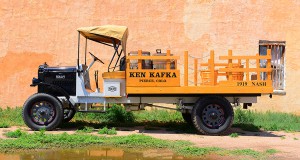 Retro is all the rage in trucking today. Seminole-style paint schemes and tapered bumpers can be found on plenty of rigs today as an homage to the decades past of trucking. There is an aura that surrounds the classic era of trucking – the ‘60s and ‘70s – when a hot mechanical engine and a set of sticks was the big ticket ride. There is also an aura that surrounds the drivers of that time – they were the last American cowboys and outlaws, and they were hearty men with a free-spirited attitude. Back then, you had to be tough, but if it weren’t for the trucks and drivers that came before them, there would be no “retro age” to even speak of or emulate at all.
Retro is all the rage in trucking today. Seminole-style paint schemes and tapered bumpers can be found on plenty of rigs today as an homage to the decades past of trucking. There is an aura that surrounds the classic era of trucking – the ‘60s and ‘70s – when a hot mechanical engine and a set of sticks was the big ticket ride. There is also an aura that surrounds the drivers of that time – they were the last American cowboys and outlaws, and they were hearty men with a free-spirited attitude. Back then, you had to be tough, but if it weren’t for the trucks and drivers that came before them, there would be no “retro age” to even speak of or emulate at all.
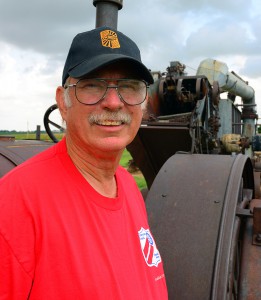 The drivers of the “retro age” came from a long line of tough, get-it-done drivers. And perhaps no drivers in the history of trucking had to be tougher than those present in trucking’s infancy and formative years of the first few decades of the twentieth century. Unfortunately, as with all things historical, the more time between them and us, the vaguer, foggier, and unknown things become. But Ken Kafka of Pierce, Colorado has done his part in preserving a little bit of history that gives a small window into what trucking was like in the early times of this important industry.
The drivers of the “retro age” came from a long line of tough, get-it-done drivers. And perhaps no drivers in the history of trucking had to be tougher than those present in trucking’s infancy and formative years of the first few decades of the twentieth century. Unfortunately, as with all things historical, the more time between them and us, the vaguer, foggier, and unknown things become. But Ken Kafka of Pierce, Colorado has done his part in preserving a little bit of history that gives a small window into what trucking was like in the early times of this important industry.
Seen here is Ken Kafka’s 1919 Nash 2-ton truck. Nash’s history begins with the Thomas B. Jeffery Company, an auto manufacturer founded in 1902 in Kenosha, Wisconsin, and often simply referred to as Jeffery. By 1916, Charles Nash, a former president at General Motors, had acquired Jeffery, and by 1917 products were carrying the Nash nameplate. Early trucks of this period were essentially re-badged Jeffery trucks featuring minor design changes, mostly to the radiator. The re-badging of trucks was epitomized most by the Quads – a four-wheel drive truck originally made by Jeffery, among others, which would come to carry the Nash nameplate. Nash Motors would become a very famous nameplate in the American motoring world, eventually merging with Hudson and later becoming American Motors Company, or AMC, famous (or more infamous) for producing “classic” cars such as the Rambler and Gremlin.
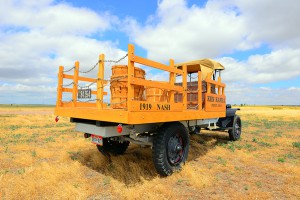 But, during those early years, Nash was also a truck manufacturer, and Ken’s 1919 2-ton is a prime example of the sorts of products offered. Nicknamed “Old Chugger” for obvious reasons, the truck is bare bones to the most extreme degree. Powered by a 22.5 horsepower headless, inline 4-cylinder gas engine mated to a 4-speed transmission, the truck is utilitarian more than anything. The interior, if it may be called that, has only what’s needed, lacking any gauges except for an ammeter. Monitoring the mechanicals of the truck comes more from what one can smell, hear, and feel than what gauges may tell. The only protection from the outside elements comes from a canvas top above the driver’s head – the truck has no doors or any sort of windows or windshield. The suspension components are simple, with leaf-springs at each corner. Perhaps the most unique comfort feature of Ken’s Nash is the optional pneumatic tires, sitting on spoke wheels, which is an odd option, for the period, on a truck.
But, during those early years, Nash was also a truck manufacturer, and Ken’s 1919 2-ton is a prime example of the sorts of products offered. Nicknamed “Old Chugger” for obvious reasons, the truck is bare bones to the most extreme degree. Powered by a 22.5 horsepower headless, inline 4-cylinder gas engine mated to a 4-speed transmission, the truck is utilitarian more than anything. The interior, if it may be called that, has only what’s needed, lacking any gauges except for an ammeter. Monitoring the mechanicals of the truck comes more from what one can smell, hear, and feel than what gauges may tell. The only protection from the outside elements comes from a canvas top above the driver’s head – the truck has no doors or any sort of windows or windshield. The suspension components are simple, with leaf-springs at each corner. Perhaps the most unique comfort feature of Ken’s Nash is the optional pneumatic tires, sitting on spoke wheels, which is an odd option, for the period, on a truck.
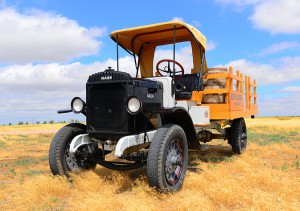 The most interesting mechanical component of the truck is probably the rear axle. Most people would laugh at the prospect of moving 4,000 pounds of cargo with a 22.5 hp engine but, in the time of the Nash pictured here, that was all that was available. The answer was simple: gear reduction. Since the gear reduction available through the transmission and differential was not adequate, the rear axle features hub-reduction pinion-and-ring gears, as well. In an effort to prevent wheel slipping, the differential is also auto-locking, proving the rear axle to be surprisingly complex and advanced for its age, as auto-locking rear-ends and hub-reduction can still be found in common use today.
The most interesting mechanical component of the truck is probably the rear axle. Most people would laugh at the prospect of moving 4,000 pounds of cargo with a 22.5 hp engine but, in the time of the Nash pictured here, that was all that was available. The answer was simple: gear reduction. Since the gear reduction available through the transmission and differential was not adequate, the rear axle features hub-reduction pinion-and-ring gears, as well. In an effort to prevent wheel slipping, the differential is also auto-locking, proving the rear axle to be surprisingly complex and advanced for its age, as auto-locking rear-ends and hub-reduction can still be found in common use today.
Ken Kafka acquired the Nash seen here in the early ‘90s. Initially doing a partial restoration of the truck, including fabricating the wood-stake body, Ken had the truck in driving condition within a year. By 2007, however, Ken had disassembled the truck to the frame rails and engine and began a full restoration on the old truck. Excluding the engine, which has never been apart since Ken acquired the truck, Ken tore the truck down and rebuilt all of the suspension components, performed body work, and painted the truck the simple gray and black scheme it wears today. The rebuild was done primarily following Nash plans and literature, and it is now in better-than-factory condition.
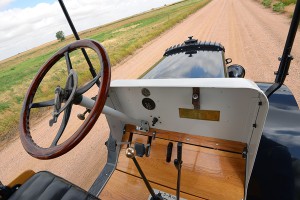 At 64 years old, Ken is retired and spends most of his time working on his vintage trucks, as well as his farm and construction equipment, now. Born in Wyoming and Raised in Colorado, Ken served stateside in the U.S. Army from 1970 to 1972 and later trained to become an office machine technician, working for the same outfit for 23 years until folding, and then four years as an independent technician. After spending time as an office equipment technician, he worked for the Greeley Museum for nine years until retiring. Other equipment in Ken’s collection includes a 1929 Coleman D40X (featured in June 2007), a 1918 Nash Quad, a 1933 Coleman E54, and a 1968 Kaiser Deuce-and-a-Half, similar to the truck he drove in the Army. Ken also has a 1926 Davenport locomotive with a 1925 caboose, as well as numerous farm and crawler tractors. Ken’s private collection and miniature museum serves as a unique walk through the history of trucking and machinery, showcasing both rare and odd-ball trucks, in addition to the machines that helped plow and build America.
At 64 years old, Ken is retired and spends most of his time working on his vintage trucks, as well as his farm and construction equipment, now. Born in Wyoming and Raised in Colorado, Ken served stateside in the U.S. Army from 1970 to 1972 and later trained to become an office machine technician, working for the same outfit for 23 years until folding, and then four years as an independent technician. After spending time as an office equipment technician, he worked for the Greeley Museum for nine years until retiring. Other equipment in Ken’s collection includes a 1929 Coleman D40X (featured in June 2007), a 1918 Nash Quad, a 1933 Coleman E54, and a 1968 Kaiser Deuce-and-a-Half, similar to the truck he drove in the Army. Ken also has a 1926 Davenport locomotive with a 1925 caboose, as well as numerous farm and crawler tractors. Ken’s private collection and miniature museum serves as a unique walk through the history of trucking and machinery, showcasing both rare and odd-ball trucks, in addition to the machines that helped plow and build America.
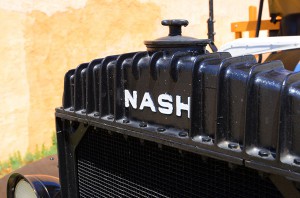 Puttering down the dirt roads of Northern Colorado in “Old Chugger” (Ken was kind enough to trust me behind the wheel of his Nash), it was impossible not to ponder the history of trucking. The simple consideration of what it meant to be a truck driver in the teens and ‘20s was surreal. With a cruising speed around 16 mph in the Nash, it was a nowhere-fast sort of profession that required patience, toughness, and a tremendous mind for repair. What it took to cover just 70 or 80 miles a day in a truck like this was nothing short of a miracle. One needed to be competent in every facet of the vehicle they were controlling – dealing with a breakdown was something the driver had to wholly control themselves when they were 100 miles from home. The roads were rough, muddy, and often uncharted. There were no mobile phones (not many “regular” phones, either) and very little protection from the elements – but the job had to get done. Indeed, the formative years of trucking were a time of experimentation, and some things worked while others didn’t, but the men who pushed these trucks down the road were anything but steering wheel holders!
Puttering down the dirt roads of Northern Colorado in “Old Chugger” (Ken was kind enough to trust me behind the wheel of his Nash), it was impossible not to ponder the history of trucking. The simple consideration of what it meant to be a truck driver in the teens and ‘20s was surreal. With a cruising speed around 16 mph in the Nash, it was a nowhere-fast sort of profession that required patience, toughness, and a tremendous mind for repair. What it took to cover just 70 or 80 miles a day in a truck like this was nothing short of a miracle. One needed to be competent in every facet of the vehicle they were controlling – dealing with a breakdown was something the driver had to wholly control themselves when they were 100 miles from home. The roads were rough, muddy, and often uncharted. There were no mobile phones (not many “regular” phones, either) and very little protection from the elements – but the job had to get done. Indeed, the formative years of trucking were a time of experimentation, and some things worked while others didn’t, but the men who pushed these trucks down the road were anything but steering wheel holders!
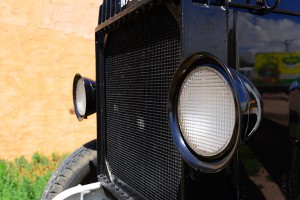 We at 10-4 Magazine would like to thank Ken for his time in getting “Old Chugger” ready for the photo shoot and for trusting us to percolate down the back roads in it. Driving this old truck really gives you a feel for what it must have been like back in those early days of trucking. It was an eye-opening (and bone-jarring) experience!
We at 10-4 Magazine would like to thank Ken for his time in getting “Old Chugger” ready for the photo shoot and for trusting us to percolate down the back roads in it. Driving this old truck really gives you a feel for what it must have been like back in those early days of trucking. It was an eye-opening (and bone-jarring) experience!
History like Ken’s truck is quickly disappearing, and with history goes an understanding of where we came from and where we are today. Retro may be all the rage in trucking right now, but if we do not preserve the very history that enabled that “retro age” to exist, we will lose an understanding and appreciation of what it all means and why it is so important, and “retro” will just become another over-used term without much meaning to the people who use it – and I, for one, hope that doesn’t happen!

3 Comments
Lucky you getting to drive that Nash.
I was lucky over 20 years ago I had a boss who owned a 1928 AB Mack and he asked me if I’d like to drive it to a private show a few miles away for him. Heck yeh!
If I could drive any truck I ever drove once again it would be that old Mack.
Reading this article reminds me of some that I read in Truck magazine from England. Over there, at the turn of the century, some trucks were steam powered and they were monsters! In fact, two different branches of the Foden family built trucks, steam under the Foden name (which became part of PACCAR before it was shut down recently) and diesel under ERF brand (which was affiliated with Western Star in Australia before it went under not long ago). Steam powered trucks-that still messes with my head!
Really enjoyed the article. The article was very well written. I have great admiration for the restoration work Ken performs.